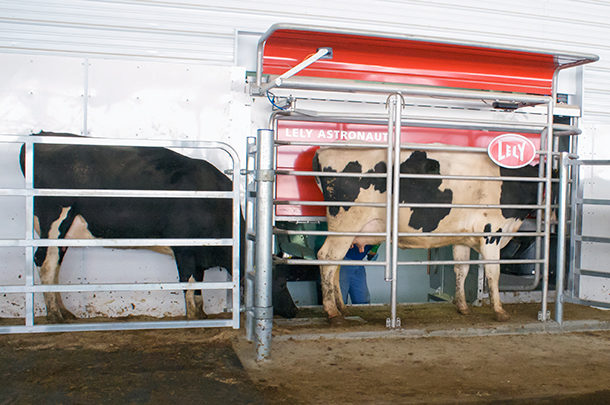What should be the criteria to prioritize for choosing a bull when using robotics? As Shakespeare once said, “That is the question …”
1. For myself, whether using robot milkers or not, when the time comes to select a bull, the first criterion for a breeder should be somatic cell count and resistance to mastitis. Never use bulls with an index greater than 3 for proven sires and 2.85 for genomic sires (in order to leave you a margin).
The cost of mastitis (treatment, lost milk, additional work, etc.) and the risks of recurrence, as well as the risks of contaminating the bulk tank with antibiotics, should be enough reason to convince you to avoid using these bulls even if their conformation is generally good.
2. In my opinion, feet and legs are the next priority. Good heel depth should help prevent hoof infections. Along these same lines, a good rear-leg rear view should favour connecting the robot milker by avoiding pressure from the rear legs on the rear udder – in order for the milker to cling to the cow’s teats in the middle or toward the end of milking.
3. Another important criterion is the mammary system. Sceptics would be amazed at the robot milker’s ability to connect to a poor udder. Attention in udder selection should focus especially on teat position and length.
Therefore, it is important to work to have teats that are not too long or too short, as well as in an adequate position that appears to be not too pushed to the back or too far in the front.
However, my expertise has led me to observe that one of the major reasons related to problems with connecting cows to the robot milker is the difficulty in seeing the rear teats due to a lower inverted udder.
Unfortunately, the industry provides very little or no data about bulls on this subject. More emphasis will surely be placed on this in the coming years with the increase in popularity of robot use.
4. In my previous point, I discussed connection difficulties, which leads me to talk about my fourth point: milking speed. Given that a robot has a limit related to the number of cows that it can milk in a day, one of the ways to increase its productivity is to supply it with cows that are quick to milk.
5. The last criterion I would like to share with you is temperament. There is a difference between an aggressive cow at the feeder and a stressed cow.
We want to have calm cows at the robot milker and aggressive ones at the feeder – not stressed cows that hold in their milk and try to pass between two stalls when they encounter another individual. For comparison purposes, sports enthusiasts like players with character (aggressive); nonetheless, it is deplorable when they take stupid penalties.
Finally, these factors are, in my opinion, the keys to success in terms of genetics when using robot milkers. Don’t forget – the best cows with robots are the ones that we don’t see.
They don’t fail to connect or need “mastitis attention,” and they are never in the group that is late to arrive for milking. Robotic milkers are incredible tools that are going to revolutionize milk production, but you will still be the manager. PD
Jean-Dominic Caron is a robot milker advisor for Ciaq.
PHOTO: Staff photo.






